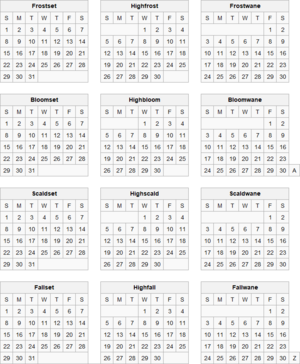Elyrian calendar

The Elyrian calendar is a solar calendar with 12 months of 30 to 31 days each, in addition to one intercalary day at the end of the year, known as Year-End, which is not part of any month or week and generally coincides with the Winter solstice. A regular Elyrian year consists of 365 days, with a Leap year of 366 days occurring roughly every four years. This second intercalary day, known as the Leap Day, is added in between the sixth and seventh months of the year and is likewise not part of any month or week.
Structurally, the calendar can be subdivided into four seasonal quarters of three months each. Each quarter has exactly 91 days, which are divided simultaneously in 13 weeks or 3 months. This quarterly and yearly regularity makes it a Perennial calendar, meaning that there is a permanent equivalence between specific days of the month and specific weekdays.
Calendar epoch
The origins of the Elyrian calendar are unknown, with proof of its usage dating as far back as the 1000s BC. During this period, dating employed several points of reference, such as the political terms of Consuls or the Regnal eras of Emperors, or more rarely in relation to the traditional year of the founding of Elyria (1159 BC).
In the aftermath of the Calamity of Elyria, the massive scale of the event and the political instability associated with it made the usage of Regnal eras dubious, with multiple claimants to the Imperial throne and the Imperial city itself completely destroyed. So it was that the Calamity Era came to be established, at first informally and later on as the standard adopted by the Faith of the Sixteen.
Years in the Calamity Era are labeled BC (Before Calamity) or AC (After Calamity), Year One being the year of the event.
Week
A week in the Elyrian calendar is a time unit equal to seven days. It is the standard time period used for cycles of rest days. The Classical or Calendar week begins on Sunday and ends on the rest day of Saturday, while the Modern or Common week begins on Monday and ends on Saturday and Sunday, which collectively form the weekend.
| 1 | 2 | 3 | 4 | 5 | 6 | 7 |
| Sunday | Monday | Tuesday | Wednesday | Thursday | Friday | Saturday |
| 1 | 2 | 3 | 4 | 5 | 6 | 7 |
| Monday | Tuesday | Wednesday | Thursday | Friday | Saturday | Sunday |
Month
A month in the Elyrian calendar is a time unit equal to 30 to 31 days. Each seasonal quarter is made up of three months of 31, 30 and 30 days respectively.
| No. | Common Name | Elyricized name | Length in days |
|---|---|---|---|
| 1 | Frostset | Snow Moon | 31 |
| 2 | Highfrost | Rain Moon | 30 |
| 3 | Frostwane | Wind Moon | 30 |
| 4 | Bloomset | Bloom Moon | 31 |
| 5 | Highbloom | Flower Moon | 30 |
| 6 | Bloomwane | Meadow Moon | 30 |
| Leap Day (only on Leap years) | 1 | ||
| 7 | Scaldset | Harvest Moon | 31 |
| 8 | Highscald | Heat Moon | 30 |
| 9 | Scaldwane | Fruit Moon | 30 |
| 10 | Fallset | Vintage Moon | 31 |
| 11 | Highfall | Mist Moon | 30 |
| 12 | Fallwane | Frost Moon | 30 |
| Year-End | 1 | ||
Date format
The legal and cultural standards for writing dates vary between countries that employ the Elyrian calendar, particularly in relation to endianness. The following table shows inscription standards in big-endian (YYYY/MM/DD) and small-endian (DD/MM/YYYY) formats. Dates for the Leap Day and Year-End are conventionally represented by using the first and final letters of the alphabet respectively. Below are examples in the Valentian alphabet, where the letters A and Z are used, as well as in the Elyrian alphabet, where the letters Ava and Yis are used instead.
| Format | Scaldset 15th 1590 15th of the Harvest 1590 |
Year-End 1590 | Lead Day 1590 |
|---|---|---|---|
| YYYY/MM/DD | 1590/07/15 | 1590/Z |
1590/A |
| DD/MM/YYYY | 15/07/1590 | Z/1590 | A/1590 |
